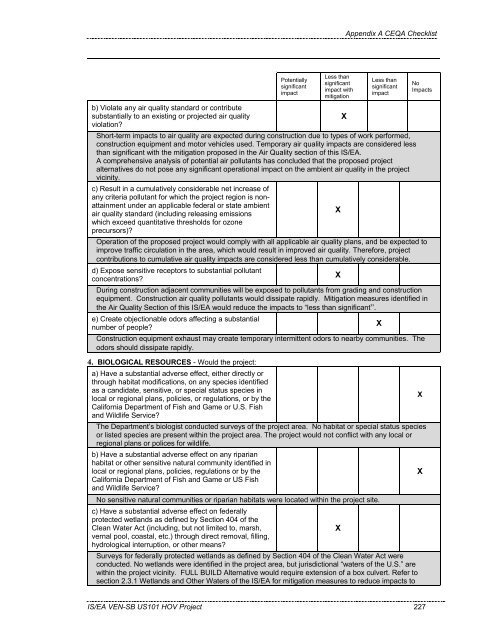Chapter 1 - Caltrans - State of California
Chapter 1 - Caltrans - State of California
Chapter 1 - Caltrans - State of California
You also want an ePaper? Increase the reach of your titles
YUMPU automatically turns print PDFs into web optimized ePapers that Google loves.
) Violate any air quality standard or contribute<br />
substantially to an existing or projected air quality<br />
violation?<br />
Potentially<br />
significant<br />
impact<br />
Less than<br />
significant<br />
impact with<br />
mitigation<br />
Appendix A CEQA Checklist<br />
Less than<br />
significant<br />
impact<br />
Short-term impacts to air quality are expected during construction due to types <strong>of</strong> work performed,<br />
construction equipment and motor vehicles used. Temporary air quality impacts are considered less<br />
than significant with the mitigation proposed in the Air Quality section <strong>of</strong> this IS/EA.<br />
A comprehensive analysis <strong>of</strong> potential air pollutants has concluded that the proposed project<br />
alternatives do not pose any significant operational impact on the ambient air quality in the project<br />
vicinity.<br />
c) Result in a cumulatively considerable net increase <strong>of</strong><br />
any criteria pollutant for which the project region is nonattainment<br />
under an applicable federal or state ambient<br />
air quality standard (including releasing emissions<br />
which exceed quantitative thresholds for ozone<br />
precursors)?<br />
X<br />
X<br />
No<br />
Impacts<br />
Operation <strong>of</strong> the proposed project would comply with all applicable air quality plans, and be expected to<br />
improve traffic circulation in the area, which would result in improved air quality. Therefore, project<br />
contributions to cumulative air quality impacts are considered less than cumulatively considerable.<br />
d) Expose sensitive receptors to substantial pollutant<br />
concentrations?<br />
During construction adjacent communities will be exposed to pollutants from grading and construction<br />
equipment. Construction air quality pollutants would dissipate rapidly. Mitigation measures identified in<br />
the Air Quality Section <strong>of</strong> this IS/EA would reduce the impacts to “less than significant”.<br />
e) Create objectionable odors affecting a substantial<br />
number <strong>of</strong> people?<br />
Construction equipment exhaust may create temporary intermittent odors to nearby communities. The<br />
odors should dissipate rapidly.<br />
4. BIOLOGICAL RESOURCES - Would the project:<br />
a) Have a substantial adverse effect, either directly or<br />
through habitat modifications, on any species identified<br />
as a candidate, sensitive, or special status species in<br />
local or regional plans, policies, or regulations, or by the<br />
<strong>California</strong> Department <strong>of</strong> Fish and Game or U.S. Fish<br />
and Wildlife Service?<br />
The Department’s biologist conducted surveys <strong>of</strong> the project area. No habitat or special status species<br />
or listed species are present within the project area. The project would not conflict with any local or<br />
regional plans or polices for wildlife.<br />
b) Have a substantial adverse effect on any riparian<br />
habitat or other sensitive natural community identified in<br />
local or regional plans, policies, regulations or by the<br />
<strong>California</strong> Department <strong>of</strong> Fish and Game or US Fish<br />
and Wildlife Service?<br />
No sensitive natural communities or riparian habitats were located within the project site.<br />
c) Have a substantial adverse effect on federally<br />
protected wetlands as defined by Section 404 <strong>of</strong> the<br />
Clean Water Act (including, but not limited to, marsh,<br />
vernal pool, coastal, etc.) through direct removal, filling,<br />
hydrological interruption, or other means?<br />
Surveys for federally protected wetlands as defined by Section 404 <strong>of</strong> the Clean Water Act were<br />
conducted. No wetlands were identified in the project area, but jurisdictional “waters <strong>of</strong> the U.S.” are<br />
within the project vicinity. FULL BUILD Alternative would require extension <strong>of</strong> a box culvert. Refer to<br />
section 2.3.1 Wetlands and Other Waters <strong>of</strong> the IS/EA for mitigation measures to reduce impacts to<br />
IS/EA VEN-SB US101 HOV Project 227<br />
X<br />
X<br />
X<br />
X<br />
X

















